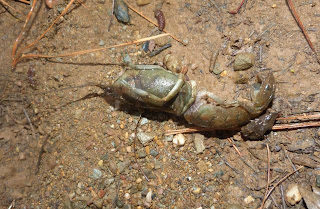Spinelessness in Carwoola
No, not about the NSW Premier, but some tales and pictures about invertebrates seen in the past few days.
The first tale arose when the small dog became very interested in a small ephemeral watercourse beside our drive. It trickles over rocks and is full of rank grass and is prime legless-reptile country. On peering closely, no reptiles were visible but a fairly recently deceased yabbie was found. As I didn't have my camera with me an image will have to wait (assuming a nocturnal scavenger has not munched it in the meantime). Here we go:
Although it is looking a little 'used' this is due to ants doing what ants do well, rather than, as I expected, Kookaburras, Ravens, foxes and other vertebrate carnivores/omnivores givng their digestions some work.
The most interesting aspect of this is that the site of finding is about:
The next yarn focuses on our Buddleja (possibly B. davidii - named after Pere David of the eponymous deer fame).
This has taken its time to come into flower this year but has finally done so and, living up to its vernacular name of Butterfly Bush, had a good collection of lepidopterids on this afternoon. I use the order name since some of them were not the subdivision of moths called butterflies but day flying Noctuids, possibly Phalaenioides sp. In the second image the proboscis is visible going down the tube.
The other species present in good numbers were butterflies: Common Browns (Heteronympha merope).
"Oh what big eyes you've got!"
In the meantime Frances drew my attention to flowering on a Eucalyptus macrorhyncha near the house. She commented that there were many honeyeaters up there. They were as faras I could see all Yellow-faced Honeyeaters. However I found when looking through my binoculars that the flowers were well endowed with Plague Soldier Beetles which is how this event gets a mention in an invertebrate focused post.
The beetles become more visible if you click on the image to expand it (look for the red dots I have added).
The first tale arose when the small dog became very interested in a small ephemeral watercourse beside our drive. It trickles over rocks and is full of rank grass and is prime legless-reptile country. On peering closely, no reptiles were visible but a fairly recently deceased yabbie was found. As I didn't have my camera with me an image will have to wait (assuming a nocturnal scavenger has not munched it in the meantime). Here we go:
Although it is looking a little 'used' this is due to ants doing what ants do well, rather than, as I expected, Kookaburras, Ravens, foxes and other vertebrate carnivores/omnivores givng their digestions some work.
The most interesting aspect of this is that the site of finding is about:
- 100m horizontally and 5m vertically from the Creek; and
- 200m in a straight line (at least 300m as water flows) horizontally from our dam.
The next yarn focuses on our Buddleja (possibly B. davidii - named after Pere David of the eponymous deer fame).
This has taken its time to come into flower this year but has finally done so and, living up to its vernacular name of Butterfly Bush, had a good collection of lepidopterids on this afternoon. I use the order name since some of them were not the subdivision of moths called butterflies but day flying Noctuids, possibly Phalaenioides sp. In the second image the proboscis is visible going down the tube.
The next image earns a place because it shows some proboscis - my default quality standard!
Another proboscis image. The length of this organ is quite astonishing: a butterfly called Errol?
At the time of taking most of these photos I was actually out looking for swifts (sometimes called Spine-tails) which had been reported by a friend who lives nearby. As is frequently the case that was unsuccessful but the event was also spinetailless!
On the next afternoon I was seeing if anything new was on the Buddlejah and was delighted to find this blue-banded Hymenopterid. I initially thought it to be a Blue-banded Bee (although it didn't look hairy enough) but my friend Roger Farrow has advised "(It) is a WASP not a bee – although it could be called a hybrid as it is a sand wasp Bembix sp in the family Sphecidae which is part of the superfamily Apiodea (bees etc) rather than wasps (Vespoidea)."
A proboscis shot!"Oh what big eyes you've got!"
The third element of the post relates to spiders. I have got a rather powerful headlight which I often wear when out after dark. Last night I was taking some prawn shells up to the dam and noticed a number of reflections - some ice-blue, others brilliant green - coming off the grass of our lawn. As they were moving they were raindrops. In each case it turned out to be a spider. Some of them bolted down burrows (which I had not previously noticed) in the grass while others toughed it out on the surface. Tonight I will take the camera out if the weather is appropriate.
In the meantime Frances drew my attention to flowering on a Eucalyptus macrorhyncha near the house. She commented that there were many honeyeaters up there. They were as faras I could see all Yellow-faced Honeyeaters. However I found when looking through my binoculars that the flowers were well endowed with Plague Soldier Beetles which is how this event gets a mention in an invertebrate focused post.















Comments